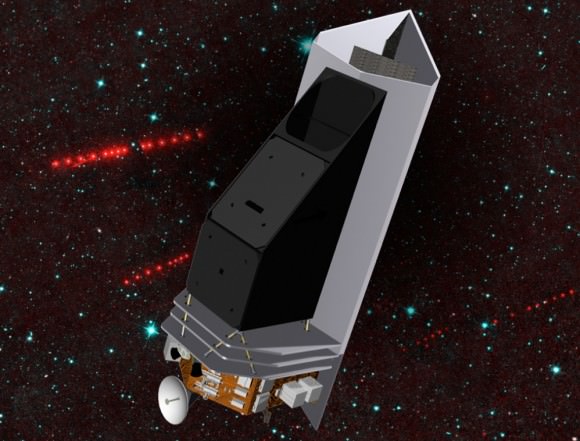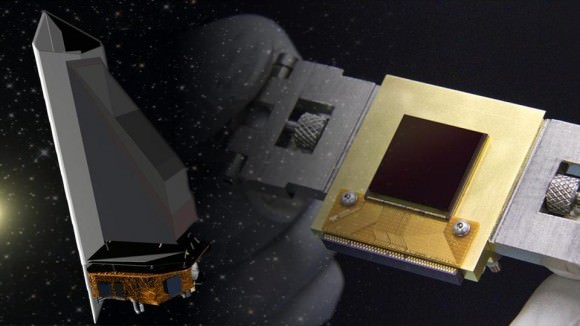In February of 2014, NASA put out the call for submissions for the thirteenth mission of their Discovery Program. In keeping with the program’s goal of mounting low-cost, highly focused missions to explore the Solar System, the latest program is focused on missions that look beyond Mars to new research goals. On September 30th, 2015, five semifinalists were announced, which included proposals for sending probes back to Venus, to sending orbiters to study asteroids and Near-Earth Objects.
Among the proposed NEO missions is the Near Earth Object Camera, or NEOCam. Consisting of a space-based infrared telescope designed to survey the Solar System for potentially hazardous asteroids, the NEOCam would be responsible for discovering and characterizing ten times more near-Earth objects than all NEOs that have discovered to date.
If deployed, NEOCam will begin discovering approximately one million asteroids in the Main Belt and thousands of comets in the course of its 4 year mission. However, the primary scientific goal of NEOCam is to discover and characterize over two-thirds of the asteroids that are larger that 140 meters, since it is possible some of these might pose a threat to Earth someday.

The technical term is Potentially Hazardous Objects (PHO), and it applies to near-Earth asteroids/comets that have an orbit that will allow them to make close approaches to Earth. And measuring more than 140 meters in diameter, they are of sufficient size that they could cause significant regional damage if they struck Earth.
In fact, a study conducted in 2010 through the Imperial College of London and Purdue University found that an asteroid measuring 50-meters across with a density of 2.6 grams per cubic centimeter and a speed of 12.7 kps could generate 2.9 Megatons of airburst energy once it passed through our atmosphere. To put that in perspective, that’s the equivalent of about nine W87 thermonuclear warheads!
By comparison, the meteor that appeared over the small Russian community of Chelyabinsk in 2013 measured only 20 meters across. Nevertheless, the explosive airbust caused by it entering our atmosphere generated only 500 kilotons of energy, creating a zone of destruction tens of kilometers wide and injuring 1,491 people. One can imagine without much effort how much worse it would have been had the explosion been six times as big!
What’s more, as of August 1st, 2015, NASA has listed a total of 1,605 potentially hazardous asteroids and 85 near-Earth comets. Among these, there are 154 PHAs believed to be larger than one kilometer in diameter. This represents a tenfold increase in discoveries since the end of the 1990s, which is due to several astronomical surveys being performed (as well as improvements in detection methods) over the past two and a half decades.

As a result, monitoring and characterizing which of these objects is likely to pose a threat to Earth in the future has been a scientific priority in recent years. It is also why the U.S. Congress passed the “George E. Brown, Jr. Near-Earth Object Survey Act” in 2005. Also known as the “NASA Authorization Act of 2005”, this Act of Congress mandated that NASA identify 90% of all NEOs that could pose a threat to Earth.
If deployed, NEOCam will monitor NEOs from the Earth–Sun L1 Lagrange point, allowing it to look close to the Sun and see objects inside Earth’s orbit. To this, NEOCam will rely on a single scientific instrument: a 50 cm diameter telescope that operates at two heat-sensing infrared wavelengths, to detect the even the dark asteroids that are hardest to find.
By using two heat-sensitive infrared imaging channels, NEOCam can also make accurate measurements of NEO and gain valuable information about their sizes, composition, shapes, rotational states, and orbits. As Dr. Amy Mainzer, the Principal Investigator of the NEOCam mission, explained:
“Everyone wants to know about asteroids hitting the Earth; NEOCam is designed to tackle this issue. We expect that NEOCam will discover about ten times more asteroids than are currently known, plus millions of asteroids in the main belt between Mars and Jupiter. By conducting a comprehensive asteroid survey, NEOCam will address three needs: planetary defense, understanding the origins and evolution of our solar system, and finding new destinations for future exploration.”
Dr. Mainzer is no stranger to infrared imaging for the sake of space exploration. In addition to being the Principal Investigator on this mission and a member of the Jet Propulsion Laboratory, she is also the Deputy Project Scientist for the Wide-field Infrared Survey Explorer (WISE) and the Principal Investigator for the NEOWISE project to study minor planets.
She has also appeared many times on the History Channel series The Universe, the documentary featurette “Stellar Cartography: On Earth”, and serves as the science consultant and host for the live-action PBS Kids series Ready Jet Go!, which will be debuting in the winter of 2016. Under her direction, the NEOCam mission will also study the origin and ultimate fate of our solar system’s asteroids, and finding the most suitable NEO targets for future exploration by robots and humans.
Proposals for NEOCam have been submitted a total of three times to the NASA Discovery Program – in 2006, 2010, and 2015, respectively. In 2010, NEOCam was selected to receive technology development funding to design and test new detectors optimized for asteroid and comet detection and discovery. However, the mission was ultimately overruled in favor of the Mars InSight Lander, which is scheduled for launch in 2016.
As one of the semifinalists for Discovery Mission 13, the NEOCam mission has received $3 million for year-long studies to lay out detailed mission plans and reduce risks. In September of 2016, one or two finalist will be selected to receive the program’s budget of $450 million (minus the cost of a launch vehicle and mission operations), and will launch in 2020 at the earliest.
In related news, NASA has confirmed that the asteroid known as 86666 (2000 FL10) will be passing Earth tomorrow. No need to worry, though. At its closest approach, the asteroid will still be at a distance of 892,577 km (554,000 mi) from Earth. Still, every passing rock underlines the need for knowing more about NEOs and where they might be headed one day!


I agree it’s valuable, maybe absolutely essential, to detect all the stray rock we can.
It seems to me though that the capacity to detect them from ground-based observations is getting better. Is there any risk that a mission like this will be less valuable then than it seems now? Or even entirely obsolete before it’s launched?
There’s always that risk, but not with the time frames being dealt with. The mission benefited from some refinements in 2010, and it would be deployed by the 2020s. So there’s really no danger of it becoming obsolete BEFORE its launched? After, sure! But not before.
As a star passed through our solar system only 70,000 years ago and likely disturbed orbits, it would seem long term transients may still be in play, making it prudent to get on with such a mission. Considering the lead time needed to take any action against a threatening NEO, the sooner the better. By launch time we will of course have better cameras to use in the mission too.
Just as a point of reference: W87 thermonuclear warheads are the 300 kiloton warheads that are used on the MX/Peacekeeper ICBMs (which can have up to 12 warheads/missile). The bomb dropped on Nagasaki was about 21 kilotons, for a reference to compare the destructive damage of a 300 kiloton warhead – or asteroid with the equivalent energy. We want to find them before they find us.
The book Orbital Maneuvers (http://www.orbitalmaneuvers.com/) gives a chilling, detailed account of asteroid impacts on the US and it’s deadly affects on an orbiting shuttle and space station.
Exactly, which why it says an asteroid of that size and density would have the force of about nine W87 warheads. 9 x 300 = 2700 kilotons, which is very close to 2900 kilotons (aka. 2.9 megatons)
You are right…I just didn’t know what a W87 warhead is and thought others may not appreciate just what they are and their capabilities. Thanks for a great article!